9 Types Of Tents That Campers, Hikers And Backpackers Need To Know
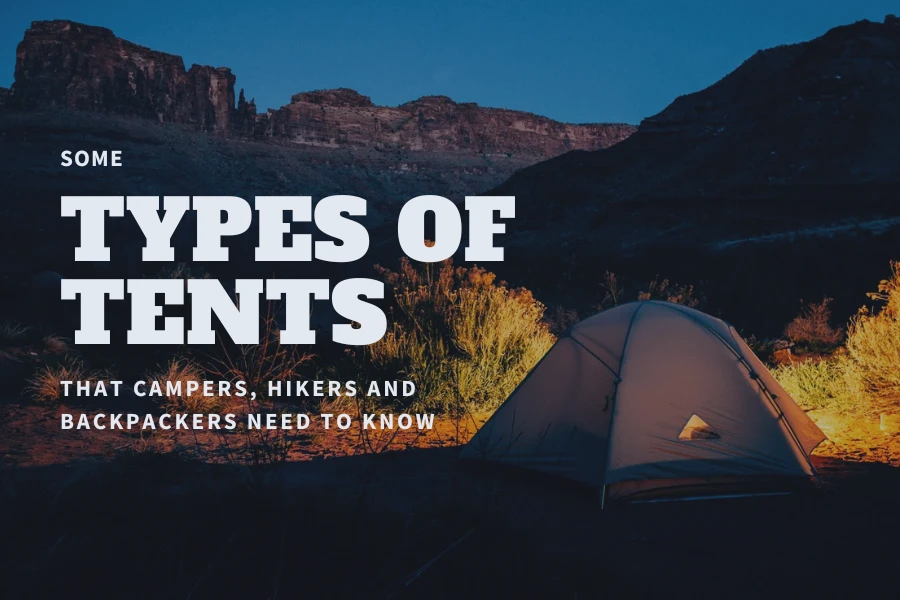
Picnics, hiking, and backpacking are probably some of the things you should do in your life. However, to have fun and memorable trips, you definitely need to prepare a lot of things. One of the indispensable items for every trip and to immerse yourself in nature is a tent. In this blog, there are some types of tents that campers, hikers, and backpackers need to know to buy the most suitable ones for your purpose.
1. A-frame Tent
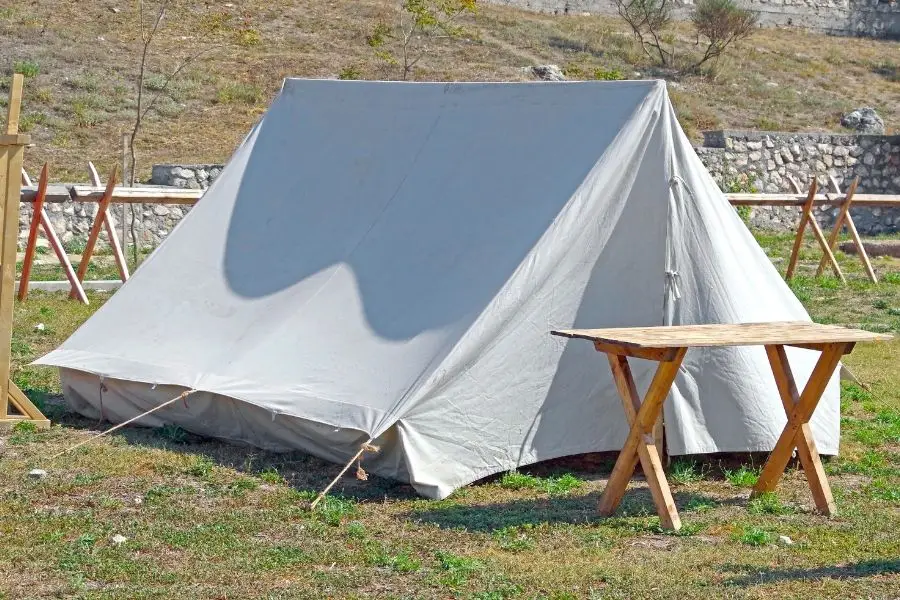
A-frame tents are also known as Ridge tents. The shape of the tent, as the name, has a triangular frame that looks like a capital letter A. The triangular structure of this tent is reinforced by poles at both ends and side ropes that fasten the tent to the ground. This is a popular tent and is also a traditional choice when it comes to types of tents. Traditional A-frame tents used canvas and wooden poles. But now, the modern one uses lighter materials like aluminum and nylon.
Strength
– Simple to set up and takedown
– High ceiling with steep slide for snow and rain fall down
– Available light selections to backpack
Weakness
– Not stable in strong winds, especially incorrect setup
– The larger the size of the tents, the more tether lines are used
– The livable space is limited
The A-frame tent is a good choice for individuals and families who camp and want an easy-to-set-up camping sleeping area.
2. Dome Tent
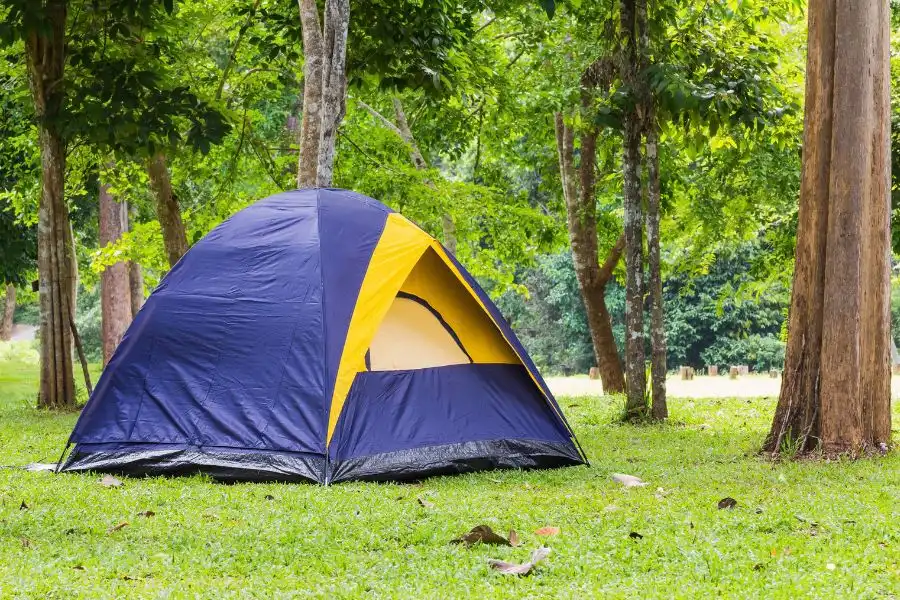
Dome tents are the most favorite type of tent today. This tent is constructed with two intersecting poles in the middle to form a hemispherical dome. The design of the dome tent has two flexible poles that cross at the corners of the rectangular tent floor and intersect at the top, creating a dome shape. Some models have an additional vestibule (or porch) in front of the door for storage and protection from dirt.
Strengths:
– Can endure strong windy conditions
– Not to collect water on the surface.
– Easy to pitch and take down by just a person
– Lightweight
– Some dome tents has decent headroom
– Can stand without the stakes
Weakness:
– Limited interior space, especially towards the edges
– Height restrictions make movement or stand up inside the tent uncomfortable
– Taller dome tents may lose stability in very strong winds
Dome tents would be recommended for beginners or families because they offer a good amount of living space while still being light and easy to set up and take down for frequent camping trips together. Moreover, if they want to have room for camping facilities such as a camping cooler, a smoker or grill and griddle.
3. Bell Tent
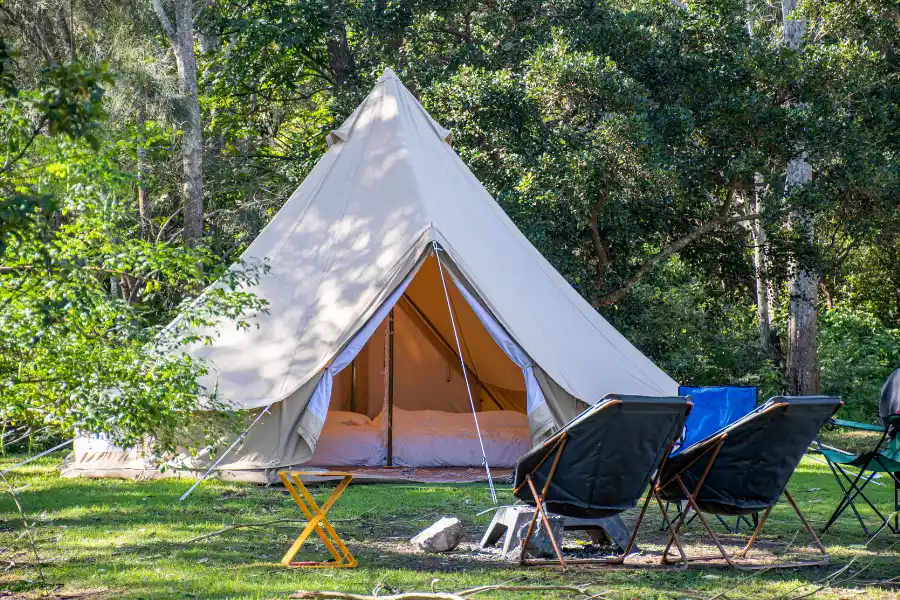
Bell tents are a popular choice for glamping due to their unique design, which is supported by a single central pole. Made from durable fabric, often canvas, the material drapes down from the center and is anchored to the ground. Their round shape and large openings create a charming, romantic atmosphere, making them ideal for both camping and special events. These tents are generally spacious, making them a great option for families or larger groups. However, because of their size, they are less portable than other tent types, which makes them unsuitable for backcountry camping.
Strength:
– Thick and permanent construction
– Breathability and may prevent cold weather.
Weakness:
– Heavier and more expensive than other synthetic tents and based on the size of the tent.
– Take time to pitch correctly
Bell tents are a reasonable choice for group camping in cooler areas, especially where temperatures drop significantly at night. They are ideal for those who enjoy a bit of luxury and want to stay as comfortable as possible while camping.
4. Bivvy Tent
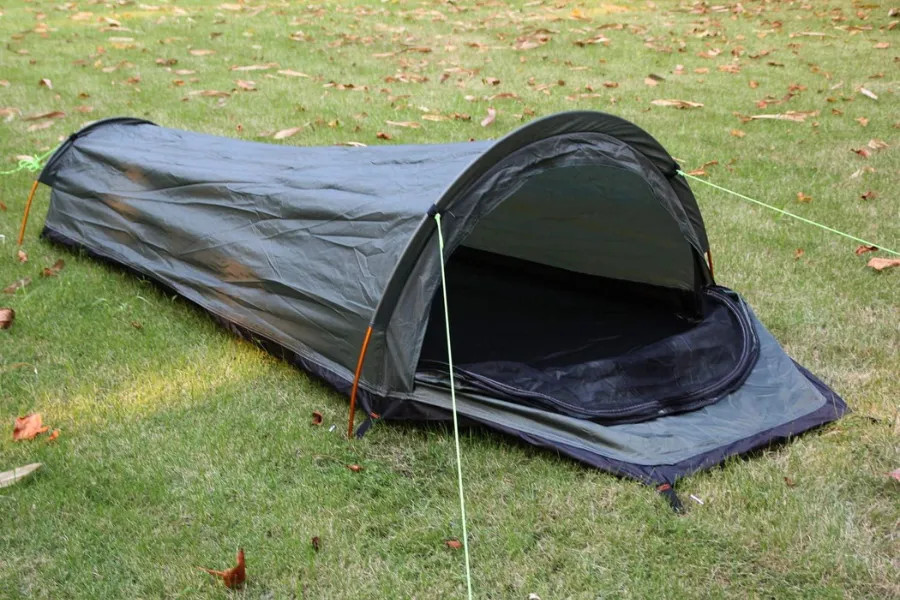
Bivvy (Bivy) tent or sack is bivouac sack in short. This sack was created as an option for mountain climbers who wanted shelter without the weight of a tent. Bivy tent is a combination between a tent and a sleeping bag, so it is ideal for individuals who do not want to bring a high weight of a tent. These kinds of tents are made from durable, waterproof nylon, and do not need much effort to pitch.
Strength:
– High-quality materials and construction
– Quick and simple to set up
– Low roof so bivy tents can resist the wind well.
Weakness:
– Expensive
– No storage space and narrow livable space can lead to claustrophobic
– Hard to protect from outside agents.
Bivvy tent is a top tent for solo wild campers, long-period hikers, bike touring, ultralight backpacking and willing to risk some weather and geographical drawbacks.
5. Geodesic & Semi-Geodesic Tent
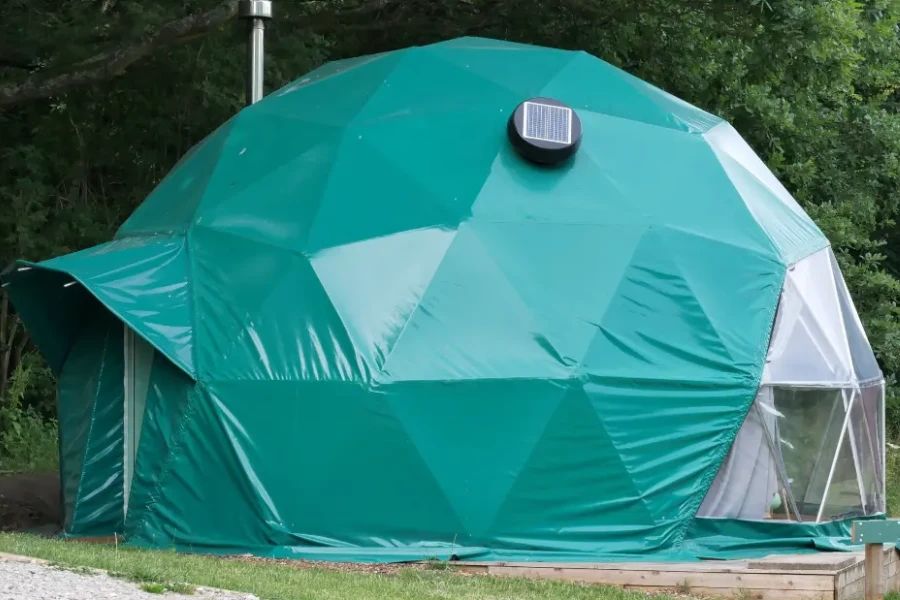
Geodesic & semi-geodesic tents feature a design similar to a dome, but they have more complex structure. The different point is that the geodesic tent has a round floor so that this type of tent needs more intersecting poles. Geodesic tents use poles to create triangles that connect, resulting in a sturdier framework. Semi-geodesic tents also follow the same design but fewer poles.
Strength:
– Can endure extreme weather conditions
– Spacious and strong foundation
– Use higher-quality materials than average camping tents.
Weakness:
– A lot of geodesic tents are heavy so as to backpack
– Too complex to pitch
– More expensive than dome tents
Semi-geodesic tents are lighter than geodesic ones. These tents are ideal tents for climbers and long-distance backpackers who are about to face severe weather conditions such as heavy rain, high winds, and snow.
6. Hammock Tent
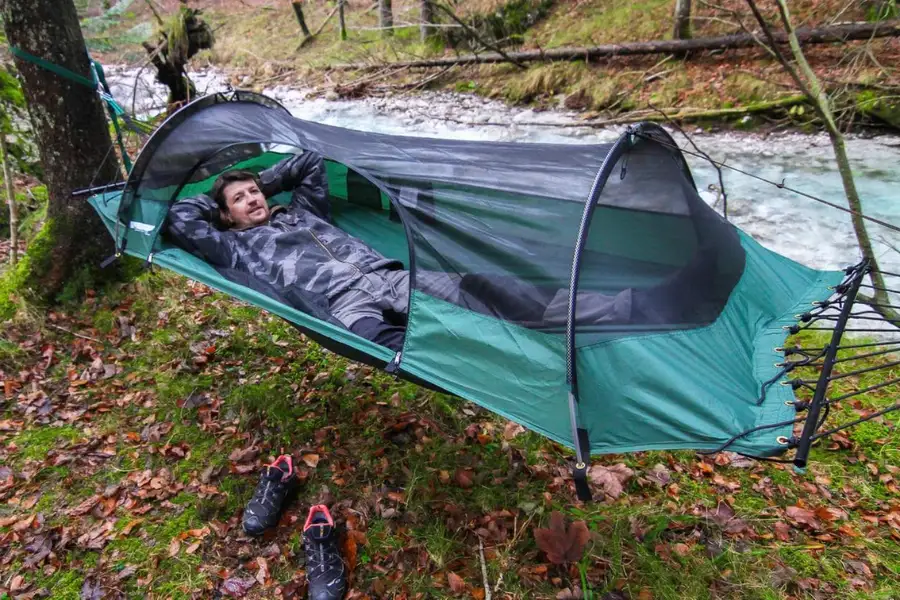
Hammock tents are one of the favourite types of tents in recent years. It became a favourite because this tent offers one of the most restful ways to sleep outdoors. Hammock tents provide an excellent alternative to conventional tents, as they are attached to trees with suspended straps, allowing for a comfortable sleep elevated above the ground.
Strength:
– Hang everywhere even on the tree or on the ground
– Lightweight to carry
– Breathability, insect and weather protection,
Weakness:
– Maximum of 2-3 people inside
– Can not prevent from low temperatures
– Not a good choice if you have kid
Hammock tents are best for single campers and backpackers, especially when they explore severe areas.
7. Teepee Tent
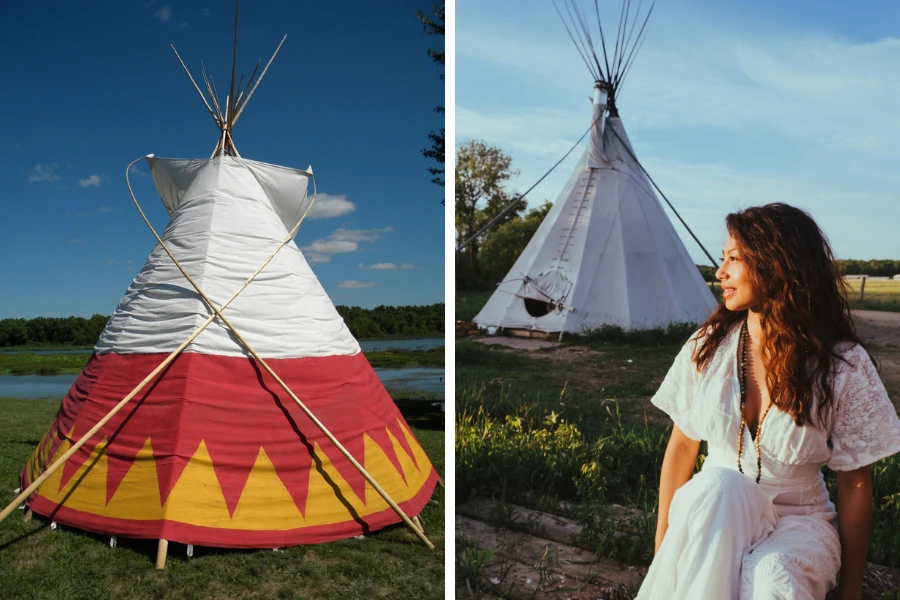
Teepee tents (or Tipi) were traditionally made of cotton canvas. This kind of tent has a conical shape like bell tents. However, it needs over one pole to stand, which also has some construction similarities with geodesic tents. Tipi tents have a high peak and are able to pitch with a single central pole. Modern models are lighter and resemble minimalist tarp setups. Teepee tents provide large headroom but can be hard to set up due to the high pitching point. This tent often does not have a floor.
Strength
– Roomy enough for a large group with comfortable livable and standing space
– Roof vents allow hot air to rise and escape
Weakness
– The canvas usually is heavy
– Hard to assemble
– Floor is not always available
– The higher the tipi, the less sturdier the structure.
Teepee tent is great for semi-permanent camping occasions with large group of people.
8. Tunnel Tent
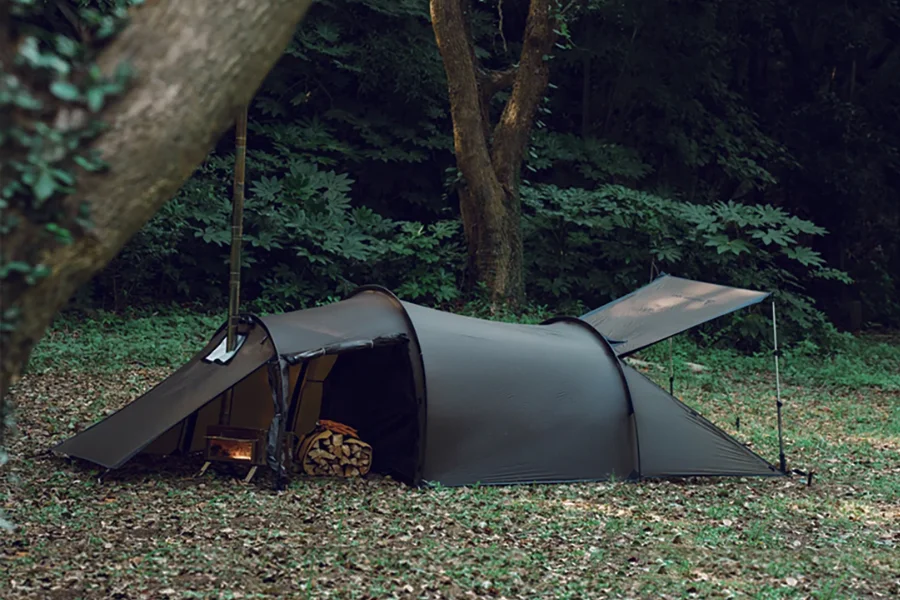
Tunnel tent is also known as a hoop tent. These tents’ poles bent parallel to form arched “hoop” shapes. Although this design is durable, the tent needs to be secured with stakes, and it’s crucial to consider the wind direction when setting it up. If you want to use tunnel tents to camp, you better choose an area with good weather. Tunnel tents should be used on softer ground because they tie rope to secure the side to the ground.
Strength:
– Large vestibule with ample headroom
– Many models have multiple “bedrooms” for added privacy.
– Easy to set up on the ground
– Can resist wind
Weakness:
– Sag and collect water in the middle
– Difficult to set up without other help
– May collapse under a heavy rain
– Heavy and bulky when packed, making them impractical for hiking
Tunnel tent is suitable for groups or families camping on long days, especially in areas with no pavilions.
9. Cabin Tent
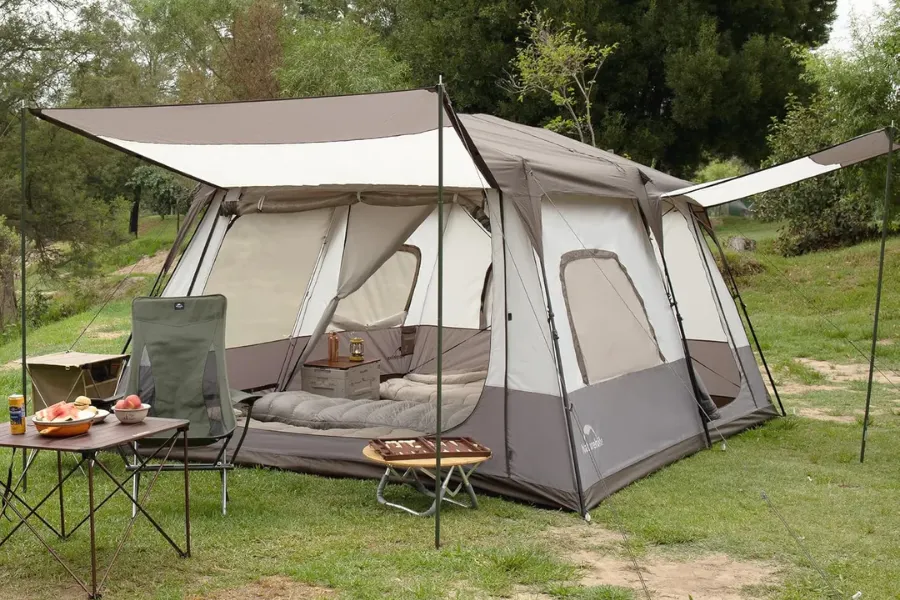
A cabin tent is designed for a spacious, comfortable, and home-like camping experience. They are particularly common for family or group camping trips thanks to their roomy interiors and ease of setup. Cabin tents have a vertical wall design. Therefore, this tent gives them a boxy, room-like shape, as opposed to the typical sloping walls of dome tents. This makes the interior space feel more like a tiny house, with higher ceilings and more usable space.
Strength:
– Spacious interior
– Feel more like an indoor space
– Have multiple rooms and dividers for privacy
Weakness:
– The larger size and heavier materials can make cabin tents harder to transport
– Weak wind resistance
– more expensive than simpler other tents
If you are about to plan a camping trip with a group or family and want extra room and comfort, a cabin tent could be an excellent choice. In addition, cabin tents are more suited for car camping than backpacking or hiking. So you can also bring other camping items such as camping stoves, coolers, etc.
Wrap Up
Above are the types of tents that backpackers, campers, etc. may already know. However, each type of tent has different advantages and disadvantages. Therefore, based on the number of people, the purpose of use, and other camping equipment for yourself, buy the right type of tent for yourself.